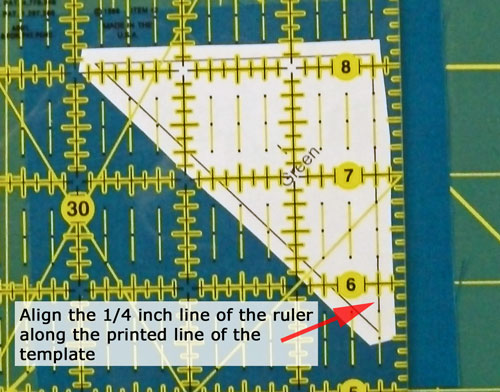This post contains affiliate links for which I receive compensation
Do I need to use templates for quilting?
by Dinah
(Queensbury, New York)
What if you find a pattern you like but the instructions are based on using templates for quilting but you don't want to use them?
Some have said something about the bias of the fabric having to do with using templates.
Reply
These days so many of the shapes that we use for piecing are cut-able with a rotary cutter, ruler, and mat.For those shapes that require lots of figuring or cutting unusual angles, pattern designers and quilt magazines find it easier to provide a template. It's simply the easiest way to communicate the exact shape in a printed form.
I have two different ways of handling templates...
- If I'm actually going to use a template shape that I can rotary cut (all the edges are straight) I use the template provided in the pattern.
I cut it out (or a copy of it) just a bit beyond the line that is the edge of the finished shape (the solid black line below). I don't worry about the seam allowance.
Then when I cut out the shapes, I use my ruler to establish the seam allowance. Simply lay the 1/4" line of your ruler on the edge of the finished size and cut.
With my far-sighted eyes, it's not always easy to line up the cut edge of a paper template with the edge of the ruler. It is much simpler for me to see the drawn line, so that's how I compensate for my eyesight.
Or... - If I don't want to use templates AND the unit is 'paper piece-able', I will replicate what I can in Electric Quilt 8 and create a paper piecing pattern for it.
I love the accuracy that the foundation piecing gives, especially at the end of the day when both my brain and my eyes are tired and I'm apt to be sloppy in my stitching.
Biased about bias...
You are right!...I had to think about it a bit...there are probably more bias edges for pieces that are cut using templates.To prevent the edges from stretching, simply refrain from unnecessary handling of the cut pieces.
Once the shapes are cut, if they're small enough, lay them on one of your rulers to transport them between your cutting mat and sewing machine. To further tame those edges, consider starching your fabric before you cut it.
Starching does add an extra step. You'll need to wash it out once the quilt is finished, but I love the stability it adds and use it for all my quilts.
Templates meant for tracing
Up to this point, we've been talking about templates used for machine piecing. If you will be hand piecing or doing needle turn applique there are some differences...and templates are a MUST.For hand piecing, templates should be cut from something that is strong enough to trace around repeatedly. Paper just won't do it. Template plastic is easy to find and economical.
You cut out the template the same size as the finished shape and trace around it on the wrong side of the fabric. This tracing line is the stitching line that you'll use as you join the patches together. You need to have it because unlike your sewing machine, there is no guide to indicate the 1/4" seam line.
For needle-turn applique, you prepare a template the same as for hand piecing. The tracing line becomes the place where the seam allowance is folded under. As an appliquer you will use your scissors to all the seam allowance that works best for you.
So...
...in the end, if there's a template in the pattern, you'll most likely need to use it to get the correct shape.I hope I've provided enough information to get you moving on to your next project. Let me know if there's something else I can do to help!
Readers! How do you use templates? Do you have other ways to work around them? What are your favorite template materials? You can share your experience with other quilters by commenting below.
Thank you!
Piecefully,
Julie Baird
Editor
Comments for Do I need to use templates for quilting?
|
||
|
||














